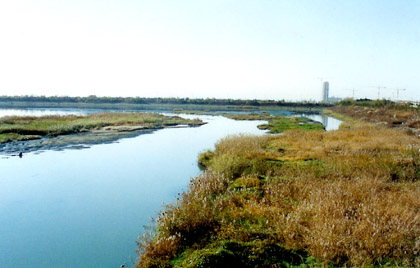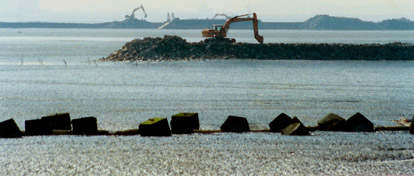
Editorial:
In February 2003 Birds Korea posted an article warning of the destruction of the internationally important tidal-flats at Song Do.
Despite being an urban location ringed by roads and construction, the area still supports several globally threatened waterbird species in internationally important concentrations, and should of course (like Saemangeum, Namyang and Asan, the Nakdong estuary and Upo) be conserved in accordance with the Ramsar Convention and the Convention on Biological Diversity. It has held one of the highest winter counts ever of Relict Gull (143, in February 2002); one of the highest winter counts of Saunders's Gull (643 in December 2001), and is now perhaps uniquely a breeding site and internationally important wintering area for the species; and it regularly supports significant concentrations of Chinese Egret in the summer and autumn. The minimum 34 individuals - a small number - counted feeding there in September 2003 nonetheless represents no less than 1.5% of the total known world population of this charismatic and threatened species.
However, national and local government supported by international business consortia, plan to convert the whole area - the remaining tidal-flats and those surrounding areas already lying idle as expansive car parks or land-ready-for-building - into a waterfront city based on the model of Chicago: much of it, according to the Korean Herald, following the design and leadership of an American company, Gale Co. (of Florham Park, New Jersey), working with Korean steel giant POSCO, and under the architectural guidance of Gene Kohn of the New York architecture firm, Kohn Pedersen Fox Associates. Their aim, according to the Korea Herald newspaper, is to create New Songdo City, a " 20 billion US dollar (equivalent) effort to transform 1, 400 acres of reclaimed waterfront property in South Korea"…(offering) "35 000 mostly for-sale residential units, 50 million square feet of office space, 10 million square feet of retail space, a convention center, about 4,000 hotel rooms, 20 million square feet of garage space, 11 public schools, a hospital, a golf-course, a 65-acre central park and an additional 210 acres of open space". This great New City of the future will be linked by a 6-mile bridge (constructed in consort with a British engineering company) from there to the Incheon international airport, direct across wide expanses of tidal-flats - that also presently support internationally important and unprotected concentrations of Great Knot and Black-faced Spoonbill among a host of other migratory species. This mega-project, mega-expensive to both the environment and in terms of tax dollars, will of course be completed without the benefits of an Environmental Impact Assessment process befitting one of the world's leading economies.
Back at the tidal-flat, still an oasis of relative calm among the roar of traffic and construction, the Future, measured in terms of sustainability, biodiversity and the international obligations to conserve both, looks far from bright….
Tim Edelsten moved to Korea in March 2002 to teach English, and has been sending regular updates to Birds Korea's Latest Bird News. His anger and sadness at the destruction of Song Do is told in the note below…
Last call for Song Do

Callous destruction of a valuable estuarine ecosystem: this is the sad unfolding reality of Song Do, a formerly vast area of inter-tidal mudflat on the edge of Incheon.
In the short 2 months I have become acquainted with the area, the devastation has accelerated to a furious and sickening pace. Rocks, pipes and debris are scattered all over the sands; the walls to enclose the mudflats are almost complete. Fishermen and gatherers of shellfish are now limited to a small area at the far end of the seaside park, and the best viewing point for the rarer gulls is a no-go zone. "Songdo Inpia", also known as "The promised land" to developers, is at the epicentre of Korea's drive to become the new economic hub of North East asia. The area - still home to a surprising diversity of birds - is marked out to become a new technological and free trade zone. Coupled with the port of Incheon, it is hoped to attract a new wave of foreign investment.

This rich, thick expanse of mud provides a staging ground for a good variety of shorebirds on migration, a few rare species, as well as holding vast numbers of commoner birds.
It is here that I found relatively plentiful Chinese Egrets, the delightfully delicate and threatened Saunders's Gull, and the distinctive Relict Gull.
The area is always favoured by flocks of Dunlin, which were complemented by the full range of waders in the autumn: Common, Terek, Marsh, and Wood Sandpipers; Common Greenshank; Common and Spotted Redshanks; godwits; Grey-tailed Tattlers; Grey, Pacific Golden, Mongolian, and Little Ringed Plovers; Red necked Stints; Eurasian and Far-eastern Curlews.
Interestingly, I saw many estuary birds temporarily resorting to freshwater area as the tide came in. There is little land for birds to use when the mud is covered - no rice paddy or open fields - thus, I noticed only a few winter geese, for example. Of the commoner species, the spectacle of thousands of Great Cormorants, Common Greenshanks and Black-tailed Gulls dotting the mudflats will remain with me.

The tragedy underway here is but a foretaste of the disaster planned for virtually every area of coastal mudflat in Korea.
Tim Edelsten, 2003.



